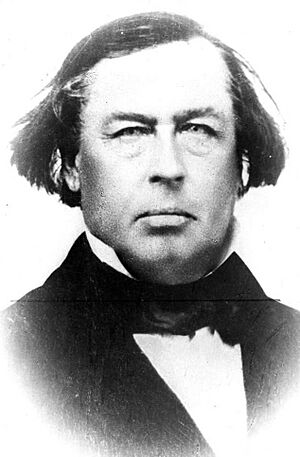James Van Ness facts for kids
Quick facts for kids
James Van Ness
|
|
|---|---|
 |
|
| 6th Mayor of San Francisco | |
| In office July 1, 1855 – July 7, 1856 |
|
| Preceded by | Stephen Palfrey Webb |
| Succeeded by | George Whelan |
| Personal details | |
| Born | 1808 Burlington, Vermont |
| Died | December 28, 1872 San Luis Obispo, California |
| Spouses |
Caroline Frances James Lesley
(m. 1836; |
| Parents | Cornelius P. Van Ness Rhoda Savage |
| Relatives | John P. Van Ness (uncle) William P. Van Ness (uncle) |
| Alma mater | University of Vermont (BA, MA) |
James Van Ness (1808 – December 28, 1872) was an American politician. He served as the 6th Mayor of San Francisco from 1855 to 1856.
Contents
James Van Ness: Early Life and Education
James Van Ness was born in Burlington, Vermont, in 1808. His father, Cornelius P. Van Ness, was a Dutch-American who became the Governor of Vermont. His mother was Rhoda Savage. James also had two famous uncles: John Peter Van Ness, who was a U.S. Representative, and William Peter Van Ness, a federal judge.
James Van Ness attended Norwich University. He later graduated from the University of Vermont. He earned a Bachelor of Arts degree in 1825 and a Master of Arts in 1831. After his studies, Van Ness became a lawyer. He worked in Vermont and Georgia before moving to California.
Mayor of San Francisco: James Van Ness's Public Service
Before becoming mayor, James Van Ness was an alderman in San Francisco. An alderman is like a city council member. He created an important rule called the "Van Ness Ordinance." This rule said that undeveloped land in the city should be surveyed. Then, it would be given back to its original owners. This law caused many lawsuits for a long time.
In 1855, Van Ness was elected Mayor as a Democrat. His time as mayor was very challenging. He faced several big problems. First, there were questions about whether his election was fair.
Later, in 1855 and 1856, two serious incidents happened. These events caused a lot of trouble in San Francisco. A group called the Vigilantes formed. They took action to deal with these situations.
Mayor Van Ness tried to get help from the California Governor to keep order in the city. However, he was unable to stop the Vigilantes from carrying out their decisions.
Van Ness left office in July 1856. This was due to a new law called the Consolidation Act. This law combined the city and county governments into one. The Van Ness Ordinance helped create the Western Addition area of San Francisco.
James Van Ness was the last mayor to be called "Mayor" during his term until 1862. After him, the city's leader was known as the "President of the Board of Supervisors." In 1860, Van Ness moved to San Luis Obispo County. He continued to work as a lawyer there. In 1871, he became a State Senator.
James Van Ness's Family Life
In January 1836, James Van Ness married Caroline Frances James Lesley. She lived from 1808 to 1858. They had two children together:
- Eliza Bird Van Ness (1838–1901), who married Frank McCoppin. Frank McCoppin also became a mayor of San Francisco.
- Thomas Casey "T.C." Van Ness
James Van Ness passed away on December 28, 1872, in San Luis Obispo, California.
Recognizing James Van Ness
A well-known street in San Francisco, Van Ness Avenue, is named after him. There are also streets named in his honor in Santa Cruz, Los Angeles, and Fresno.

